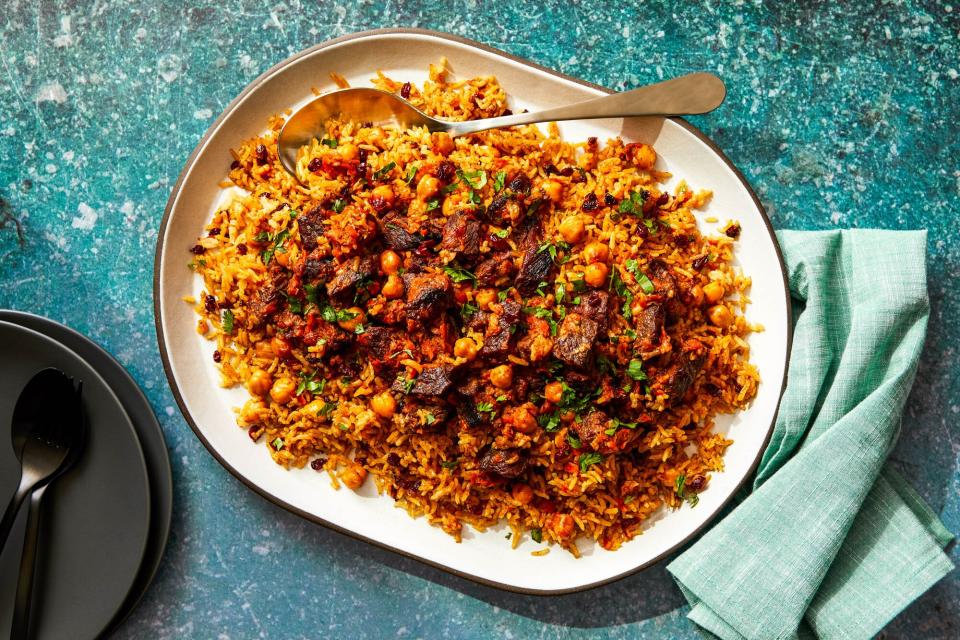Plov Isn't Just a Rice Dish. It Contains Multitudes
The first time I tried plov, the oil-slicked meat and rice pilaf that is beloved throughout Central Asia, was at a homely kosher restaurant in Rego Park, Queens. Growing up eating blintzes, potato latkes, and other Eastern European Jewish dishes in suburban Chicago, I was equal parts surprised and thrilled to learn that New York City is home to tens of thousands of Bukharian Jewish immigrants hailing from Uzbekistan, Tajikistan, and Turkmenistan-as well as the dishes from home they brought with them. Amongst the unfamiliar riches on the table that evening were grilled lamb-fat skewers, savory pumpkin pastries topped with nigella seeds, hand-pulled noodle soups, and fresh pickled salads. But the cumin-perfumed rice, which came spangled with glistening cubes of meltingly tender beef, was the unrivaled star.
Uzbekis regard plov as their national dish, serving it on holidays and to guests, and layering giant cauldrons, called kazans, with rice and meat for weddings and other special occasions. It is a beguiling and sensuous dish, traditionally eaten with one's hands from a shared central vessel. The most ubiquitous versions are made with beef, lamb, or mutton. Softened onions and matchsticks of yellow carrots are standard additions, as are chickpeas, entire heads of garlic, and dried fruit including sultanas or barberries.

Photo by Rachel Vanni / Food Styling by Judy Haubert
READ MORE: Rice Is Everything: A Celebration of the World's Most Popular Food
Beyond the already remarkable basic version, the breadth and scope of dishes in the plov family are breathtaking. There are dozens, if not hundreds of variations across Central Asia made with different meats and fish, vegetables, fruit, and spices. Quince and chestnuts tend to make an appearance when in season, and plov sometimes comes scattered with tiny, iridescent boiled quail eggs. "In Azerbaijan, plov gets very fruity," said Caroline Eden, the travel writer and author of several cookbooks including Samarkand: Recipes and Stories from Central Asia and The Caucasus, which she co-authored with Eleanor Ford. "The fruit is incredible there, and you see things like sour plums, cherries, apricots, and apples making their way in."
Eden has eaten many exceptional plovs, like one in Tajikistan threaded with tiny nuggets of juicy lemon, and another made with duck in Kyrgyzstan's capital city, Bishkek. In Osh (Kyrgyzstan's second largest city), a well-regarded plov cook named Imenjon demonstrated how to smash a fork through the yielding garlic cloves hiding amongst the plov, and drag their paste through the rice, adding another layer of flavor at the table.
Plov shares a common ancestor (scholars debate whether it is ancient Persia or southern India) with a myriad of other savory rice casseroles. "The dish traveled...along the Silk Road to central Asia, where a form of it was adopted in every country," writes Gil Marks in The Encyclopedia of Jewish Food. So while Uzbekistan and Azerbaijan regard plov as a national dish, versions of pulao, polo, pilaw, pilav, or pilaf (among other names), show up on tables from Turkey to Mongolia, to Pakistan. Versions have made their way to England, France, and the United States. Plov may have also inspired rice-based dishes like risotto and paella, though Eden said if they are related, "they are more likely distant cousins than close ones."
As with any revered rice dish, plov cooks have strong opinions about which varieties are superior. Uzbekis insist on using Uzgen rice (called devzira), which grows in southern Kyrgyzstan. "The grains are short, reddish, and quite fat, but not overly sticky like risotto rice," Eden said. "It is a very flavorsome rice with a richness to it that takes well to the fat."
Uzgen-grown rice is difficult to source outside of the region, but Amnun Kimyagarov, who authored the cookbook Classic Central Asian Jewish Cuisine and Customs, writes that medium grain rice by the California-based brand Kokuho, has "proven to be an excellent choice" for plov. Meanwhile, plov made in Azerbaijan is more commonly made with long-grain varieties, so a good-quality basmati is also appropriate.
Plov is prepared by skilled chefs called oshpaz, and traditionally only by men (though some women do make it, including the oshpaz who prepared the duck plov Eden tried.) Because it is such a prestigious dish, there is a performative element to preparing it. "It is quite a sociable thing," Eden said. "It takes a long time to make, so you see men in courtyards in Uzbekistan drinking tea and catching up around the open fire, surrounded by sacks and sacks of rice." As evening falls, the rice turns soft and shiny, the meat collapses into supple, butter-soft bites, and the air grows thick with oil-sizzled spices. The occasion hardly matters; the celebration is in the pot.

